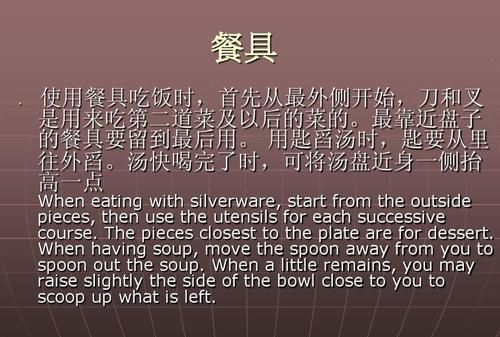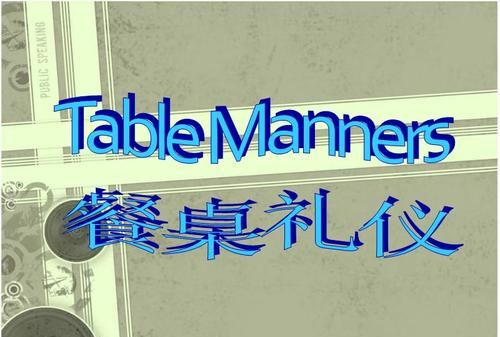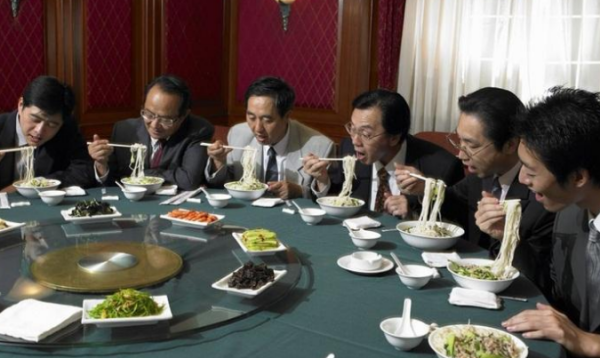本文目录
中国餐桌礼仪用英语怎么说英语
Table manners and the social exchanges and international exchanges should be about important matters. Generally state that small private dinner to have to follow certain etiquette guidelines. Of the world in different countries and cultural backgrounds of the table generated by cultural etiquette differs greatly from that.
Its causes in order to export the second chapter, which is in the background of Western culture and at the same time a mutual understanding of the importance of countries and cultural backgrounds. Chapter III on the Western table manners and cultural outlook towards the future. Key words: Chinese table manners; Western table manners; background of Chinese and Western culture;
As China's reform and opening up the pace is accelerating, increasing cross-border communication, lifestyle and the update of the active social interaction to understand the different countries and cultural etiquette of the table is necessary. Table manners not only the image of the country, is also related to international exchanges. It represents a reflection of respect and civilization. Can be better displayed in the table on our big country style礼仪之邦classic will carry forward the cultural heritage. This article summarizes the first chapter Chinese table manners, table manners and the Western differences.

英语作文餐桌礼仪
As we all know,different countries have different table manners. Today, I’d like to introduce something about Chinese table manners. It’s very necessary to learn table manners in China. In China, table manners are too much. For instance,you are not supposed to eat with knives and forks. Chinese usually use chopsticks instead. But we are not supposed to stick our chopsticks into our food. But we are supposed to pick up our bowl to eat. And we are supposed to let the old start eating first. And we are allowed to talk at the table. However, you can’t talk too loud and laugh too crazily. In fact, in China, table manners are not so serious . so , you don’t need to worry about them so much.

中西方餐桌礼仪差异英语作文
The Differences Between Chinese and Western Table Manners/etiquette
Comparison of Chinese and western Table Manners/etiquette
table manners
UK [ˈteɪbl mænəz]
US [ˈteɪbl mænərz]
n.
餐桌规矩;进餐礼节
table etiquette
UK [ˈteɪbl ˈetɪkət]
US [ˈteɪbl ˈetɪkət]
餐桌礼仪
manners是常使用复数形式,指非常普通的、连孩子都应掌握的基本的礼仪规范;etiquette则更为讲究,要比manners复杂,常随着形势的变化而改变。
Etiquette (来自法语)and manners are synonyms, but do have slightly different meanings.
Etiquette is a code of polite conduct based on social acceptance and efficiency. Simply, it means to follow rules for efficiently or politeness. Sometimes, rules of etiquette are archaic (old-fashioned) and don't make sense nowadays.
For example, it is good etiquette to sit with your back straight.
It is good etiquette to not chew loudly when at the dinner table.
It is good etiquette to dress neatly for a formal occasion.
Etiquette may change in different cultures. For example, it could be good etiquette to chew loudly when eating your food (this is just an example, haha).
Manners are polite behaviors that reflect an attitude of consideration, kindness and respect for others.
For example, saying "please" and "thank you" are good manners. Saying "excuse me" if you need to get someone's attention instead of shouting rudely is good manners. Not interrupting someone while they are talking is good manners.
Good manners are usually universal and don't change in different cultures.
Of course, the main difference on the Chinese dinner table is chopsticks instead of knife and fork, but that's only superficial. Besides, in decent restaurants, you can always ask for a pair of knife and fork, if you find the chopsticks not helpful enough.
tableware
UK [ˈteɪblweə(r)]
US [ˈteɪblwer]
n.
(商店用语)餐具
chopsticks
UK [ˈtʃɒpstɪks]
US [ˈtʃɑpˌstɪks]
n.
筷子
chopstick的复数
The real difference is that in the West, you have your own plate of food, while in China the dishes are placed on the table and everyone shares ,Perhaps it’s one of the things that surprises a Western visitor most is that some of the Chinese hosts like to put food onto the plates of their guests. In formal dinners, there are always "public" chopsticks and spoons for this purpose, but some hosts may use their own chopsticks. This is a sign of genuine friendship and politeness. It is always polite to eat the food. If you do not eat it, just leave the food in the plate.
People in China tend to over-order food, for they will find it embarrassing if all the food is consumed. When you have had enough, just say so. Or you will always overeat!
Chinese table manners of families have no intrinsic quality even there are different region and position. No matter three meals a day or guest's arrival, always bowls with chopsticks, food with soup. There is no rule for how to put the tableware. What people care about more are not the gorgeous tableware but the sumptuous food. People's dining position reflects the most obvious etiquette of Chinese table manners. In ancient society, men are supreme, and women are not allowed to sit with men on the same table. Although this is modern society, this kind of ancient etiquette still remains. Today in China, the phenomenon that men sit on the table before women can be found everywhere. The master of a family usually sits on the first-class seat. The first-class seat is usually near the interior of a room facing to the door. Once there is a guest, the master will offer the first-class seat to the guest politely. If it is an ordinary meal of family, families should start after the elder. If there is a guest, the master offer the food to the guest is essential from the beginning to the end. And the tradition of urging others to drink is also a special phenomenon.
Here are some characteristics on Chinese eating:
The real difference is that in the West, you have your own plate of food, while in China the dishes are placed on the table and everyone shares ,Perhaps it’s one of the things that surprises a Western visitor most is that some of the Chinese hosts like to put food onto the plates of their guests. In formal dinners, there are always "public" chopsticks and spoons for this purpose, but some hosts may use their own chopsticks. This is a sign of genuine friendship and politeness. It is always polite to eat the food. If you do not eat it, just leave the food in the plate.
People in China tend to over-order food, for they will find it embarrassing if all the food is consumed. When you have had enough, just say so. Or you will always overeat!
Chinese table manners of families have no intrinsic quality even there are different region and position. No matter three meals a day or guest's arrival, always bowls with chopsticks, food with soup. There is no rule for how to put the tableware. What people care about more are not the gorgeous tableware but the sumptuous food. People's dining position reflects the most obvious etiquette of Chinese table manners. In ancient society, men are supreme, and women are not allowed to sit with men on the same table. Although this is modern society, this kind of ancient etiquette still remains. Today in China, the phenomenon that men sit on the table before women can be found everywhere. The master of a family usually sits on the first-class seat. The first-class seat is usually near the interior of a room facing to the door. Once there is a guest, the master will offer the first-class seat to the guest politely. If it is an ordinary meal of family, families should start after the elder. If there is a guest, the master offer the food to the guest is essential from the beginning to the end. And the tradition of urging others to drink is also a special phenomenon.
Here are some characteristics on Chinese eating:
Can I take your order now?
Will you have some soup before the meat course?
吃荤菜前先来点汤好吗?
关于宴会知多少?
banquet
UK [ˈbæŋkwɪt]
US [ˈbæŋkwɪt]
n.
宴会;盛宴;筵席
CET6 · 考研 · TEM8 · GRE · TOEIC
复数:banquets
The state banquet国宴
SITTING
In China, any banquet, only will have one form, will be everybody sits in a circle all round. The banquet must use the round table, this formally has created (营造)one kind of unity, politeness, altogether the interest atmosphere. The delicacy delicacies place(摆放) a table of person's center, it is not only the object which table of people appreciate, taste, is also a table of person sentiment exchange intermedium.
Westerners treat with a long table, men and women sit in the owner at both ends,(男女主人坐在两头) and then the guest of honor men and women in the press and the general order of the guests seating arrangements.
关键词:
a circle
UK [ə ˈsɜːkl]
US [ə ˈsɜːrkl]
一周;一圈
all around
UK [ˌɔːl əˈraʊnd]
US [ˌɔːl əˈraʊnd]
各方面,四周
the round table
UK [ðə raʊnd ˈteɪbl]
US [ðə raʊnd ˈteɪbl]
圆桌
round-table conference
UK [raʊnd ˈteɪbl ˈkɒnfərəns]
US [raʊnd ˈteɪbl ˈkɑːnfərəns]
圆桌会议;举行圆桌会议
圆桌会议指围绕圆桌举行的会议,圆桌并没有主席位置,亦没有随从位置,人人平等。此概念源自英国传说里的亚瑟王与其圆桌骑士在卡默洛特时代的习俗。
圆桌会议是指一种平等、对话的协商会议形式。是一个与会者围圆桌而坐的会议。在举行国际或国内政治谈判时,为避免席次争执、表示参加各方地位平等起见,参加各方围圆桌而坐,或用方桌但仍摆成圆形。直到今天“圆桌会议”已成为平等交流、意见开放的代名词,也是国家之间以及国家内部,一种重要的协商和讨论形式。
a long table
the guests of honor贵宾
The order of dishes in the West(bread eater)
Dinner start with a small dish, which is often called an a starter. After the starter you will get a bowl of soup. The next dish is the main course, it usually is a beefsteak . A vegetable salad will be served. Then a delicious dessert will appear at the table . At last is a cup of tea or coffee.
Starter(英式)
UK [ˈstɑːtə(r)]
US [ˈstɑːrtər]
n.
(主菜之前的)开胃小吃,开胃品;参赛人;参赛的马(或汽车等);(赛跑等的)发令员
TEM8 Vocabulary
复数:starters
Appetizer(北美)
UK [ˈæpɪtaɪzə(r)]
US [ˈæpɪtaɪzər]
n.
(餐前的)开胃品,开胃饮料
GRE · TOEIC
复数:appetizers
The main course 主菜
The order of dishes in China (rice eater)
The meal usually begins with a set of at least four cold dishes, to be followed by the main courses of hot meat and vegetable dishes. Soup then will be served to be followed by staple food ranging from rice, noodles to dumplings. If you wish to have your rice to go with other dishes, you should say so in good time, for most of the Chinese choose to have the staple food at last or have none of them at all.
中文:渴汤 不等于英文drink soup 而是 eat soup.
This is my spoon. I like to eat soup.
这是我的勺子,我喜欢喝汤。
I eat soup with a large spoon.
我用大勺子喝汤。
Manners in the West
1) As soon as the hostess picks up her napkin, pick yours up and lay it on your lap. Sometimes a roll of bread is wrapped in it; if so, take it out and put it on your side plate.
2) The Soup Course
Dinner usually begins with soup. The largest spoon at your place is the soup spoon. lt will be beside your plate at the right-hand side.
3) The Fish Course
If there is a fish course, it will probably follow the soup. There may be a special fork for the fish, or it may be similar to the meat fork. Often it is smaller.
4) The Meat Course
The main Course is usually served by the host himself, especially if it is a fowl or a roast which need to be carved. He will often ask each guest what piece he prefers, and it is quite proper to state your preference as to lean or fat, dark (红肉 )or light (白肉) 。
5) Helping Yourself and Refusing
If a servant passes food around, he will pass the dish in at your left hand so that you can conveniently serve yourself with your right hand. Never serve yourself while the dish is on your right; it is then the turn of your neighbor on the right. It is polite to take some of everything that is passed to you. But if there is something you may not like, you may quietly say: No thank you。
6) Various rules and Suggestions
Sit up straight on your chair;
Do not put much food in your mouth at a time; Drink only when there is no food in your mouth; Try not to get into your mouth anything that will have to be taken out; Do not make any noise when you eat; Do not clean your teeth at the table or anywhere in public, either with your finger or a tooth pick/dental floss , not even with you tongue.
Receiving guests
When a guest receives an invitation to someone's home, it is common but not necessary for the guest to ask, "Could I bring anything?" If the host declines, the guest should not insist, as this insinuates that the host is unable to provide
中文:渴汤 不等于英文drink soup 而是 eat soup.
This is my spoon. I like to eat soup.
这是我的勺子,我喜欢喝汤。
I eat soup with a large spoon.
我用大勺子喝汤。
Manners in the West
1) As soon as the hostess picks up her napkin, pick yours up and lay it on your lap. Sometimes a roll of bread is wrapped in it; if so, take it out and put it on your side plate.
2) The Soup Course
Dinner usually begins with soup. The largest spoon at your place is the soup spoon. lt will be beside your plate at the right-hand side.
3) The Fish Course
If there is a fish course, it will probably follow the soup. There may be a special fork for the fish, or it may be similar to the meat fork. Often it is smaller.
4) The Meat Course
The main Course is usually served by the host himself, especially if it is a fowl or a roast which need to be carved. He will often ask each guest what piece he prefers, and it is quite proper to state your preference as to lean or fat, dark (红肉 )or light (白肉) 。
5) Helping Yourself and Refusing
If a servant passes food around, he will pass the dish in at your left hand so that you can conveniently serve yourself with your right hand. Never serve yourself while the dish is on your right; it is then the turn of your neighbor on the right. It is polite to take some of everything that is passed to you. But if there is something you may not like, you may quietly say: No thank you。
6) Various rules and Suggestions
Sit up straight on your chair;
Do not put much food in your mouth at a time; Drink only when there is no food in your mouth; Try not to get into your mouth anything that will have to be taken out; Do not make any noise when you eat; Do not clean your teeth at the table or anywhere in public, either with your finger or a tooth pick/dental floss , not even with you tongue.
Receiving guests
When a guest receives an invitation to someone's home, it is common but not necessary for the guest to ask, "Could I bring anything?" If the host declines, the guest should not insist, as this insinuates that the host is unable to provide adequate hospitality, especially for more formal situations . such as dinner parties. Hosts accepting such offers should be clear, but not demanding; if one does not think the guest will be able to provide the correct item, politely decline the offers. It is polite to announce your presence when arriving at an informal occasion, such as a backyard barbecue, or if dropping by unexpectedly, although the latter is a faux pas unless the host has previously indicated that such visits are welcome.
Guests wishing to give flowers should consider sending them earlier in the day or the day before a dinner party rather than bring them just as the hostess is busy with last minute dinner preparations. A host might keep a vase handy if he or she suspects that flowers, wile brought by guests.
A guest may offer to help a host, and it is more appropriate in more familiar situations. The host should turn down help offered by people he is less familiar with. Judith Martin
states: "A good guest offers to help but does not insist if the offer is firmly refused ". A good host never requests help and offers mild resistance if it is wanted, but firm resistance if it is not.
General standards
These etiquette topics are relevant in both the United States and Canada and pertain no basic interactions in society. It is a understood that these are general rules to which in certain contexts and depending on the expectations of the parties involved,
there may be exceptions.
Manners in China
1)Spitting Out the Bones
In China it is common practice to spit things out on the table or the floor. Often food has small pieces of bone or other inedible parts that need to be removed from the mouth. Using chopsticks, a hand or a tissue is a polite way around the problem.
2)Touching Tables
Though in the West it is sometimes considered rude to put one's elbows on the dining table, this is quite acceptable in China, particularly when eating noodles.
3)Noise and Smoking
Eating noisily is allowed in China. Slurping, smacking the lips and leaving the mouth open when eating can be viewed as demonstrating enjoyment of the food and a friendly atmosphere in China.
Smoking is also permitted in most Chinese restaurants. A way round this, in larger restaurants, is to request a side room you’re your meal, which will have its own door to insulate you from the noise and smoke.
4)Dessert
Eating something sweet for dessert is not a Chinese custom. Sweet things can be found hidden among everything else on a Chinese menu. Fruit salads and caramel covered apple are Chinese sweet dishes that are popular with Westerners.
5)Drinking
Beer is very popular in China. The other popular alcoholic drink is rice wine. Beware, this can be very strong .In China, drinking alcohol is still mainly a male custom. Male guests are routinely offered alcohol and, cigarettes at meal times. Just politely refuse if you don't want them. An empty glass is always refilled, no matter about protests is that the guest has had enough, as a mark of politeness or good will often a refusal has to be given three times.

中国餐桌礼仪20条英语怎么写的
一、入座的礼仪。先请客人入座上席,再请长者入座客人旁依次入座,入座时要从椅子左边进入。入座后不要动筷子,更不要弄出什么响声来,也不要起身走动。如果有什么事要向主人打招呼(正对门口的为上座,一般是根据对方的身份地位来安排)。
The etiquette of taking a seat. First invite the guests to take a seat, and then invite the elderly to take a seat. Next to the guests, take a seat in turn. When taking a seat, enter from the left side of the chair. Don't move your chopsticks, make any noise,or get up and walk. If there is anything to say hello to the host (the one facing the door is the seat, which is generally arranged according to the identity of the other party)
二、进餐时,先请客人中长者动筷子。夹菜时每次少一些,离自己远的菜就少吃一些,吃饭时不要出声音,喝汤时也不要出声响,喝汤用汤匙一小口一小口地喝,不宜把碗端到嘴边喝。
When dining, please ask the elderly to move their chopsticks first. Eat less when you're far away from you. Don't make any noise when you eat, and don't make any noise when you drink soup. When you drink soup,take small mouthfuls with a spoon. It's not suitable to drink the bowl to your mouth. When the soup is too hot, drink it after it's cold. Don't drink it while blowing。
三、汤太热时凉了以后再喝,不要一边吹一边喝。有的人吃饭喜欢使劲咀嚼脆食物,发出很清晰的声音来,这种做法是不合礼仪要求的,特别是和众人一起进餐时,就要尽量防止出现这种现象。
Some people like to chew crisp food hard and make a clear voice when they eat. This practice is not in line with the etiquette requirements, especially when dining with people, we should try our best to prevent this phenomenon。

扩展资料
“餐桌礼仪”是一门很深刻的学问,它体现了一种儒家文化的传承,传播和精髓。比如,“尊老爱幼”,“长幼有序”在餐桌礼仪上就很讲究,我们都是先给长辈先盛饭,在给比自己年幼的盛饭,最后给自己盛饭。
再比如:从古至今很多重要的商业洽谈,重要决定,或是朋友间的相互往来,基本上都是和餐桌离不开的,所以餐桌礼仪至关重要。
中国古代就有所谓的站有站相,坐有坐相,吃有吃相,睡有睡相。这里说的进餐礼仪就是指吃相,要使吃相优雅,既符合礼仪的要求,也有利于我国饮食文化的继承和发展。
以上就是关于餐桌礼仪用英语怎么说,中国餐桌礼仪用英语怎么说英语的全部内容,以及餐桌礼仪用英语怎么说 的相关内容,希望能够帮到您。
